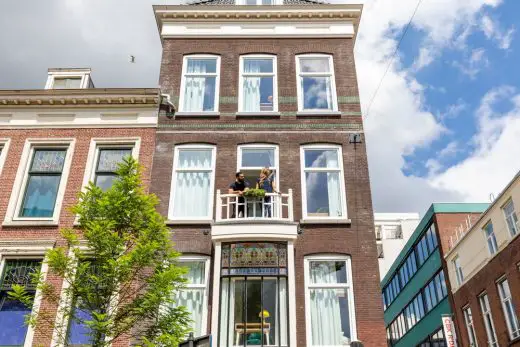The role of glass bricks in architecture, a timeless design element, Building walling material tips, Online brickwork advice
The Role of Glass Bricks in Architecture: A Timeless Design Element
6 April 2025
Glass bricks have been a staple in architectural design for over a century. Known for their unique ability to blend natural light with privacy, glass bricks offer a modern, functional, and aesthetic solution to various design challenges. Their versatility, durability, and timeless appeal make them a popular choice in both contemporary and traditional architecture. In this blog post, we’ll explore how glass bricks are used in architecture, their benefits, and how they continue to shape the design landscape today.
What Are Glass Bricks?
Glass bricks are hollow, translucent blocks made from molded glass. They come in a variety of sizes, textures, and designs, which allow for creative and functional use in a range of architectural applications. Unlike traditional glass panes, glass bricks are typically thicker and more durable, offering both privacy and light diffusion. They can be used as walls, windows, partitions, or decorative features, and are often set in mortar or adhesive for easy installation.
Historical Significance of Glass Bricks
The history of glass bricks dates back to the early 20th century. Initially developed in the 1900s, they gained popularity in the 1920s and 1930s as a way to provide natural light in spaces where traditional windows weren’t feasible. During the industrial revolution, architects sought ways to bring light into dark spaces like basements, factories, and public buildings without sacrificing privacy or security. Glass bricks became the perfect solution, offering a way to brighten rooms while keeping them secluded from the outside world.
Throughout the 20th century, glass bricks became synonymous with the Art Deco and mid-century modern architectural styles. They were incorporated into skyscrapers, hospitals, and homes, becoming a signature feature of the period. Today, glass bricks continue to be used in architecture, but they have evolved in terms of design and functionality, making them a versatile option for a wide range of modern spaces.
Benefits of Glass Bricks in Architecture
- Natural Light and Privacy
One of the primary advantages of glass bricks is their ability to bring natural light into a space while maintaining privacy. Unlike traditional windows, glass bricks obscure the view from the outside, preventing people from seeing in. This makes them ideal for spaces like bathrooms, shower walls, and partition walls where privacy is essential, but a connection to the outdoors and natural light is still desired.
- Energy Efficiency
Glass bricks can also contribute to energy efficiency. Their insulation properties help to regulate temperature, keeping spaces cooler in the summer and warmer in the winter. This can reduce the need for artificial lighting and heating, leading to energy savings in the long run. In addition, the use of glass bricks in exterior walls can create a thermally efficient barrier that helps maintain a comfortable indoor environment.
- Durability and Low Maintenance
Glass bricks are incredibly durable and low-maintenance. Made from high-strength glass, they are resistant to wear and tear, moisture, and mildew, which makes them perfect for use in high-humidity areas like bathrooms, kitchens, and basements. Unlike traditional windows that may crack or shatter, glass bricks are more resilient and can withstand significant pressure. They require minimal upkeep, often only needing a periodic cleaning to keep them clear and free of water spots.
- Sound Insulation
Another often-overlooked benefit of glass bricks is their soundproofing capabilities. Due to their solid construction and the air pockets within, glass bricks can provide an extra layer of noise insulation. This makes them ideal for use in noisy environments, such as urban areas or in commercial buildings, where reducing sound transmission is important.
Common Uses of Glass Bricks in Architecture
- Interior Walls and Partitions
Glass bricks are frequently used as interior walls and partitions in both residential and commercial spaces. They can be used to divide rooms, create privacy, and offer a visual separation between different areas without the need for a solid wall. In offices, glass bricks are often used in conference rooms or to create partitions that allow light to pass through while maintaining privacy.
- Shower Walls and Bathroom Features
Glass bricks are especially popular in bathroom designs, particularly for shower walls. They allow natural light to fill the space, making it feel open and airy, while still providing the necessary privacy. In modern bathrooms, glass bricks are often used to create sleek, contemporary shower enclosures, often paired with other materials like stone or ceramic tiles to add texture and contrast.
- Architectural Facades and Exterior Walls
Glass bricks are also used in architectural facades and exterior walls. Their ability to diffuse light makes them a unique and visually striking feature on building exteriors. They’re often used in commercial buildings, like museums, galleries, and offices, where the goal is to create a visually appealing exterior while still allowing for natural light to illuminate the interior. When used on the exterior of buildings, glass bricks can be an effective way to create a modern, sleek look that also supports energy efficiency.
- Staircases and Walkways
In some architectural designs, glass bricks are incorporated into staircases or walkways, creating a dramatic effect while allowing light to pass through the steps. These designs often combine the durability and light-transmitting properties of glass bricks with other materials, such as metal or wood, to create a striking modern look.
- Decorative Accents and Art Installations
Glass bricks can also be used as decorative accents or even as part of larger art installations. Their translucent quality, along with the variety of textures and colors available, makes them a versatile material for creating unique design elements. Whether incorporated into a wall, used as part of a floor design, or arranged as an artistic feature, glass bricks can add an element of creativity and sophistication to any space.
Conclusion
Glass bricks have long been a favorite material for architects and designers, offering both aesthetic appeal and practical benefits. Whether used to provide natural light, enhance privacy, or create unique architectural features, glass bricks continue to play an important role in contemporary design. Their timeless qualities, durability, and versatility ensure that glass bricks will remain a relevant and valuable material in architecture for years to come. Whether you’re looking to brighten up a bathroom or design an entire building facade, glass bricks are an excellent choice for any architectural project.
Comments on this The Role of Glass Bricks in Architecture: A Timeless Design Element article are welcome.
Brick
Bricks
The evolution of brick and mortar designs in NZ
Can brick slips be used externally guide
2021 Brick in Architecture Awards
Building Articles
Residential Architecture
The Bellhop Hotel, Witte de Withstraat, Rotterdam, The Netherlands
Architecture: local

photo : Joey Van Dongen
The Bellhop Hotel
Comments / photos for the The Role of Glass Bricks in Architecture: A Timeless Design Element page welcome






